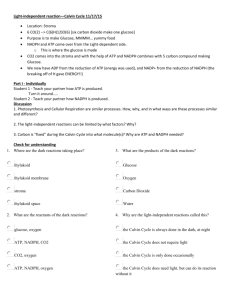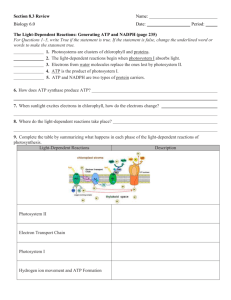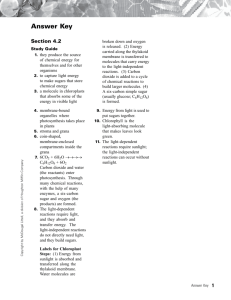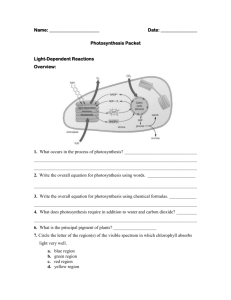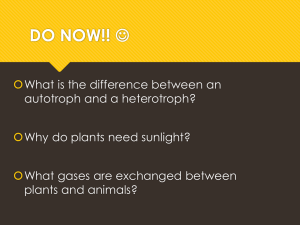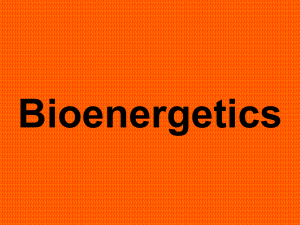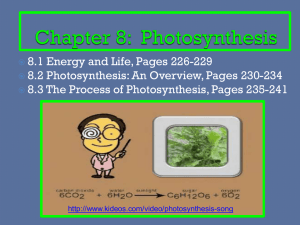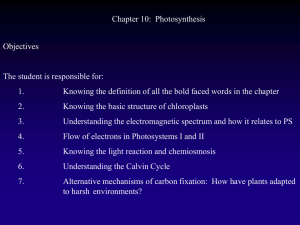The Light-Independent Reactions: Producing Sugars
advertisement
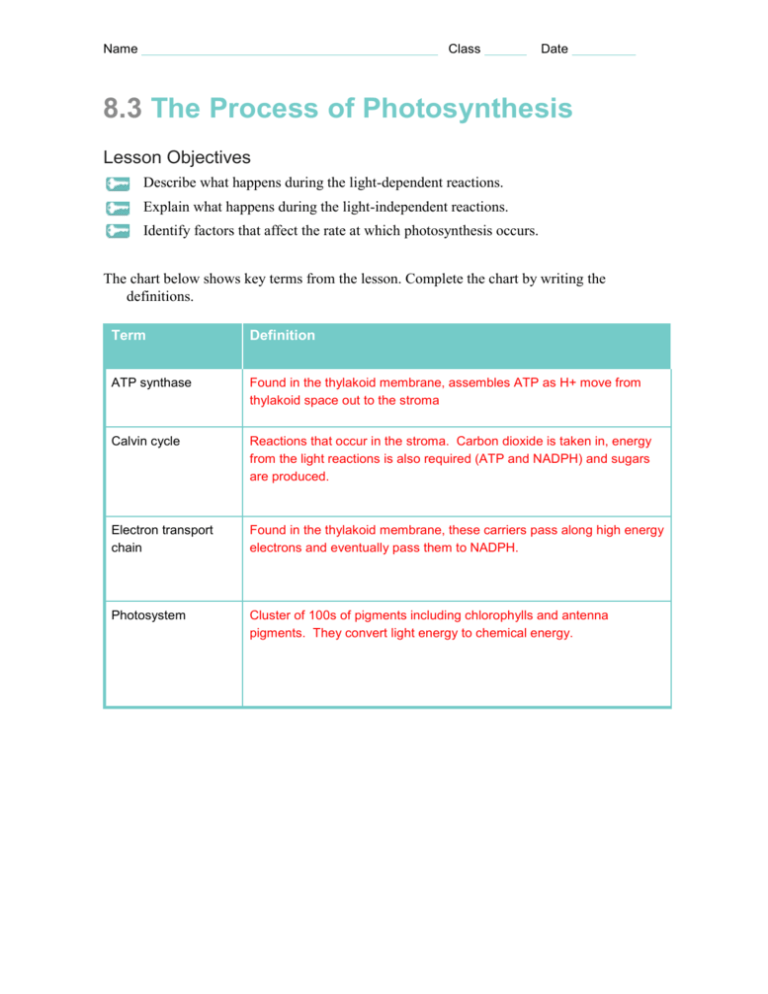
Name Class Date 8.3 The Process of Photosynthesis Lesson Objectives Describe what happens during the light-dependent reactions. Explain what happens during the light-independent reactions. Identify factors that affect the rate at which photosynthesis occurs. The chart below shows key terms from the lesson. Complete the chart by writing the definitions. Term Definition ATP synthase Found in the thylakoid membrane, assembles ATP as H+ move from thylakoid space out to the stroma Calvin cycle Reactions that occur in the stroma. Carbon dioxide is taken in, energy from the light reactions is also required (ATP and NADPH) and sugars are produced. Electron transport chain Found in the thylakoid membrane, these carriers pass along high energy electrons and eventually pass them to NADPH. Photosystem Cluster of 100s of pigments including chlorophylls and antenna pigments. They convert light energy to chemical energy. BUILD Understanding Flowchart A flowchart is a way to show the steps in a process. As you read, complete the flowchart to show the steps involved in the light-dependent reactions of photosynthesis. Light is absorbed by the pigments Water provides electrons as it is split light-dependent reactions The proton gradient is used to drive ATP synthesis Oxygen is made as a waste product from splitting water NADPH captures the high energy electrons Light-Dependent and Light-Independent Reactions Photosynthesis involves two sets of reactions. The light-dependent reactions need sunlight. They use energy from this sunlight to produce energy-rich compounds, like ATP. The lightindependent reactions use these energy-rich compounds to produce sugars from carbon dioxide. Complete the T-chart. Write the phrases in the box that belong in each side of the chart. Use energy from the sun Take place in the stroma Use carbon dioxide Take place in thylakoids Produce oxygen Require water Produce sugars Also called Calvin cycle Convert ADP into ATP Light-dependent Reactions Light-independent Reactions Use energy from the sun Use carbon dioxide Produce oxygenConvert ADP into ATP Produce sugars Take place in thylakoids Take place in the stroma Require water Also called Calvin cycle The Light-Independent Reactions: Producing Sugars Both ATP and NADPH are produced by the light-dependent reactions of photosynthesis. The Calvin cycle uses the energy in ATP and NADPH to produce high-energy sugars. A model of the Calvin cycle is shown below. Follow the directions. 1. Circle the places where ATP and NADPH are used. 2. Draw an X over the two 3-carbon molecules that are removed from the cycle to produce sugars, lipids, and other compounds. Calvin Cycle Sugars and other compounds Answer the questions. 3. Circle the letter of each statement that is true about the Calvin cycle. A. The main products of the Calvin cycle are six carbon dioxide molecules. B. Carbon dioxide molecules enter the Calvin cycle from the atmosphere. C. Energy from ATP and high-energy electrons from NADPH are used to convert 3carbon molecules into higher-energy forms. D. The Calvin cycle uses 6 molecules of carbon dioxide to produce a single 6-carbon sugar molecule. 4. Why are the reactions of the Calvin cycle also called the light-independent reactions? Although they use ATP and NADPH from the light reactions, the Calvin cycle does not directly require light. Chapter Vocabulary Review Crossword Puzzle Complete the puzzle by entering the term that matches the description. Across Down 4. energy carrier cells use to transport high-energy electrons 1. liquid part of the inside of a chloroplast 6. cluster of pigments and proteins that absorbs light 7. a saclike photosynthetic membrane found in chloroplasts 8. energy carrier made as a result of photosystem II 9. process of using the sun’s energy to make food 10. man who worked out the light-independent reactions 2. chemical that absorbs light for photosynthesis 3. light-absorbing chemical 5. organism that makes its own food For Questions 11–16, complete each statement by writing the correct word or words. 11. The light-dependent reactions occur in thylakoid membranes. 12. Carbon dioxide is used to make sugars in the light-independent reactions. 13. The light-independent reactions are also called the Calvin cycle. 14. ATP Synthase spins to provide the energy for adding a phosphate group to ADP. 15. Electron transport chains move high-energy electrons between photosystems. 16. An animal that obtains food by eating other organisms is called a(n)heterotroph.
